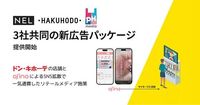On April 22, 2025, three key players in Japan's retail and marketing sectors, NEL Corporation, Hakuhodo, and pHmedia, announced the launch of an innovative advertising package aimed at bridging online and offline shopping experiences. This new initiative leverages NEL's consumer-driven marketing platform, osina, in conjunction with the unique retail environment of Don Quijote stores, creating a comprehensive marketing solution that caters to the evolving needs of consumers.
As the retail media advertising market in Japan continues to grow, projections indicate it will reach an impressive 910 billion yen in 2024, expanding to 1,750 billion yen by 2028—an approximate 3.2-fold increase. This growth reflects a significant shift in how brands engage with consumers, particularly in a market where about 90% of purchases are still made in physical stores.
The collaboration among NEL, Hakuhodo, and pHmedia combines their respective strengths: NEL's expertise in consumer-driven marketing, pHmedia’s innovative retail media strategies, and Hakuhodo's planning capabilities. The new advertising package is designed to facilitate a seamless integration of online and offline marketing efforts, enabling brands to enhance their visibility and sales through targeted campaigns.
At the heart of this initiative is osina, a platform that allows users to create and share user-generated content (UGC) related to products. Since its launch, osina has achieved remarkable success, with its UGC content exceeding 200 million views in just over a year. This platform not only fosters engagement among consumers but also drives traffic to physical stores by encouraging purchasing behaviors through social media interactions.
“This new marketing approach will enable us to deliver optimized integrated marketing and promotional activities that directly stimulate consumer action,” said Kaoru Okuda, President of pHmedia. He emphasized the importance of understanding consumer behavior through data derived from over 700 stores operated by PPIH and the approximately 15 million users of the majica app, which provides valuable purchasing insights.
By utilizing the creative content generated on osina, the advertising package will also feature digital signage in Don Quijote stores, effectively merging online buzz with in-store promotions. This strategy aims to attract not only social media users but also those who may not be active on these platforms, thereby broadening the reach of marketing efforts.
As consumer habits evolve, the demand for integrated marketing solutions that transcend the boundaries of online and offline environments has intensified. NEL has recognized this trend, reporting a staggering 205% year-on-year growth across its business operations. The company's focus on connecting brands with consumers through the osina platform has proven to be a game-changer in the retail landscape.
“We are excited to collaborate with pHmedia to offer this new retail media advertising package that harnesses the passionate content created by osina users,” said Riku Nishida, President of NEL. He noted that the partnership aims to deepen the connection between brands and consumers, ultimately driving purchasing behavior.
The timing of this launch is particularly significant as retailers are increasingly looking for ways to enhance their marketing strategies in response to changing consumer behaviors. With the rise of digital platforms, traditional marketing methods are being supplemented—or even replaced—by more dynamic, interactive approaches that engage consumers where they are most active.
The integration of osina’s UGC into Don Quijote’s retail media strategy not only provides a fresh avenue for brands to reach consumers but also aligns with the growing trend of experiential shopping. By creating a more engaging in-store environment that features content created by actual users, retailers can foster a sense of community and authenticity that resonates with today's shoppers.
In summary, the collaboration between NEL, Hakuhodo, and pHmedia marks a significant step forward in the evolution of retail marketing in Japan. By combining the strengths of each company, this new advertising package promises to deliver a more integrated and effective marketing solution that meets the demands of modern consumers.
As the retail landscape continues to evolve, initiatives like this will be crucial for brands looking to stay ahead of the competition and effectively engage with their target audiences. The future of retail marketing appears to be not just about selling products, but about creating meaningful connections between brands and consumers in an increasingly digital world.







